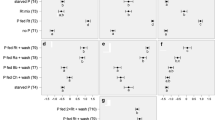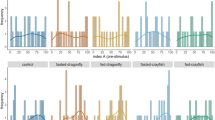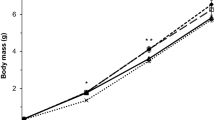Abstract
Tadpoles of Sphaerotheca breviceps raised in the laboratory from the egg stage, and hence lacking prior experience of a predator or its odors, were tested to examine their responses to a predator’s (tadpoles of Hoplobatrachus tigerinus) water-borne chemical cues. The stimulus solution was obtained following 24 h of rearing tadpoles of H. tigerinus (one tadpole per 200 mL water) that were not fed during this period. Upon exposure to the stimulus solution the activity of S. breviceps tadpoles decreased by about 90% within 5 min. Their resting period increased significantly over baseline activity, whereas the swimming period, distance traversed, and swimming spurts declined. However, whenever a test tadpole moved, its swimming velocity was high in response to stimulus solution. The antipredatory responses declined with increase in time of storage of the stimulus solution, indicating decay of the predator’s chemical cues. The findings suggest that (1) antipredator defense strategies of S. breviceps do not require prior experience of predators, (2) the predator’s chemical cues are labile in nature, and (3) the response of prey tadpoles to such cues is similar to reported behavior of anuran tadpoles in response to real predators and alarm cues.


Similar content being viewed by others
References
Chivers DP, Smith RJF (1998) Chemical alarm signaling in aquatic predator-prey systems: a review and prospectus. Ecoscience 5:338–352
Feminella JW, Hawkins CP (1994) Tailed frog tadpoles differentially alter their feeding behavior in response to non-visual cues from four predators. J N Am Benthol Soc 13:310–320
Hews DK (1988) Alarm response in larval western toads, Bufo boreas: release of larval chemicals by a natural predator and its effect on predator capture efficiency. Anim Behav 36:125–133
Hews DK, Blaustein AR (1985) An investigation of the alarm response in Bufo boreas and Rana cascadae tadpoles. Behav Neural Biol 43:47–57
Kiesecker JM, Chivers DP, Blaustein AR (1996) The use of chemical cues in predator recognition by western toad tadpoles. Anim Behav 52:1237–1245
Laurila A, Kujasalo J, Ranta E (1997) Different antipredator behaviour in two anuran tadpoles: effects of predator diet. Behav Ecol Sociobiol 40:329–336
Mathis A (2003) Use of chemical cues in detection of conspecifics predators and prey by newts, Notophthalmus viridescens. Chemoecology 13:193–197
Mathis A, Vincent F (2000) Differential use of visual and chemical cues in predator recognition and threat-sensitive predator-avoidance responses by larval newts (Notophthalmus viridescens). Can J Zool 78:1646–1652
Mathis A, Chivers DP, Smith RJF (1995) Chemical alarm signals: predator deterrents or predator attractants? Am Nat 145:994–1005
Mathis A, Murray KL, Hickman CR (2003) Do experience and body size play a role in responses of larval ringed salamander, Ambystoma annulatum, to a predator kairomones? Laboratory and field assays. Ethology 189:159–170
Miller R (1981) Simultaneous statistical inference. Springer, New York
Nicieza AG (1999) Context-dependent aggregation in common frog Rana temporaria tadpoles: influence of developmental stage, predation risk and social environment. Funct Ecol 13:852–858
Nyström P, Åbjörnsson K (2000) Effects of fish chemical cues on the interactions between tadpoles and crayfish. Oikos 88:181–190
Peterson AG, Bull CM, Wheeler LM (1992) Habitat choice and predator avoidance in tadpoles. J Herpetol 26:142–146
Petranka JW, Kats LB, Andrew S (1987) Predator-prey interactions among fish and larval amphibians: use of chemical cues to detect predatory fish. Anim Behav 35:420–425
Pfeiffer W (1966) Die verbreitung der Schreckreaktion bei Kaulquappenund dei Herkunft des Schreckstoffes. Z Vergl Physiol 52:79–98
Relyea RA (2002) Costs of phenotypic plasticity. Am Nat 159:272–282
Relyea RA, Werner EE (1999) Quantifying the relation between predator-induced behavior and growth performance in larval anurans. Ecology 80:2117–2124
Schmidt BR, Amézquita A (2001) Predator-induced behavioural responses: tadpole of the neotropical frog Phyllomedusa tarsius do not respond to all predators. Herpetol J 11:9–15
Spieler M, Linsenmair KE (1999) Aggregation behaviour of Bufo maculates tadpoles as an antipredator mechanism. Ethology 105:665–686
Stauffer H, Semlitsch RD (1993) Effects of visual, chemical and tactile cues of fish on the behavioural responses of tadpoles. Anim Behav 46:355–364
Teplitsky C, Plénet S, Joly P (2003) Tadpoles’ responses to risk of fish introduction. Oecologia 134:270–277
Thiemann GW, Wassersug RJ (2000) Patterns and consequences of behavioural responses to predators and parasites in Rana tadpoles. Biol J Linn Soc 71:513–528
Wisenden BD (2000) Olfactory assessment of predation risk in the aquatic environment. Phil Trans R Soc Lond B 355:1205–1208
Woody DR, Mathis A (1997) Avoidance of areas labeled with chemical stimuli from damaged conspecifics by adult newts, Notophthalmus viridescens, in a natural habitat. J Herpetol 31:316–318
Woody DR, Mathis A (1998) Acquired recognition of chemical stimuli from an unfamiliar predator: associative learning by adult newts, Notophthalmus viridescens. Copeia 1998:1027–1031
Acknowledgments
The study was supported by a grant from DST (SP/SO/C-29/2000) and UGC-SAP II-DRS grant from UGC, New Delhi awarded to SKS and BAS. SSS thanks the Indian Academy of Sciences, Bangalore for a Summer Fellowship.
Author information
Authors and Affiliations
Corresponding author
About this article
Cite this article
Sharma, S.S., Veeranagoudar, D.K., Shanbhag, B.A. et al. Activity of Sphaerotheca breviceps tadpoles in response to chemical cues of the predaceous tadpoles Hoplobatrachus tigerinus . J Ethol 26, 303–307 (2008). https://doi.org/10.1007/s10164-007-0061-0
Received:
Accepted:
Published:
Issue Date:
DOI: https://doi.org/10.1007/s10164-007-0061-0




